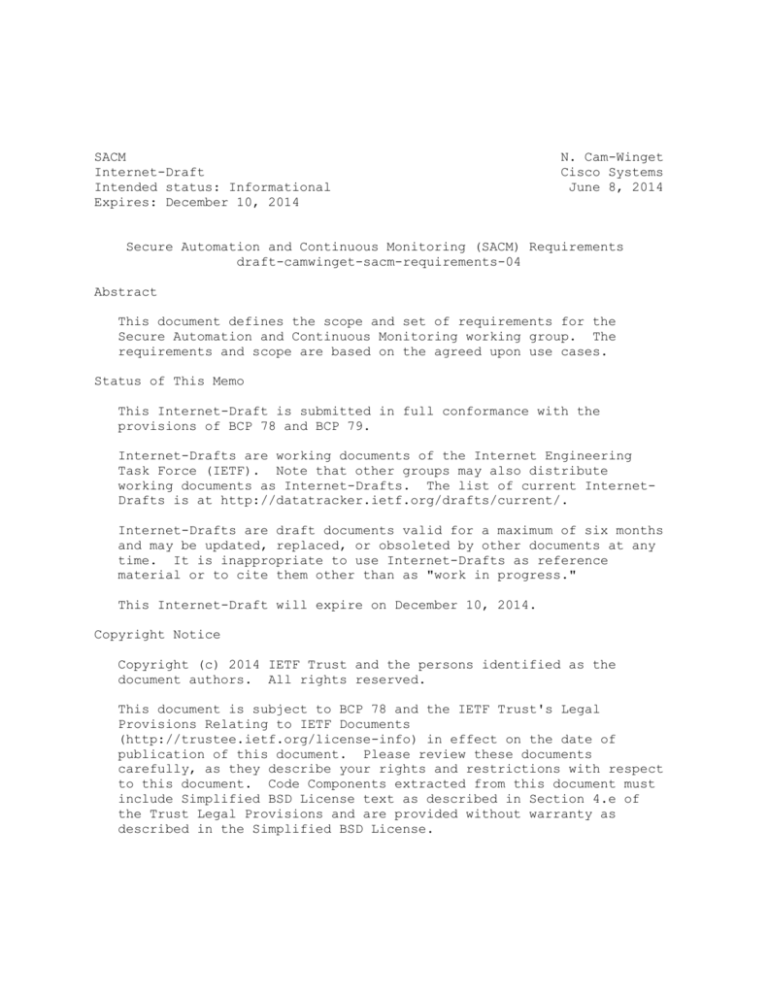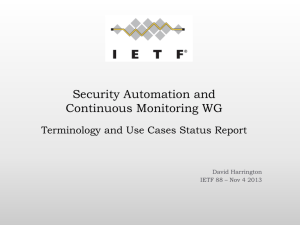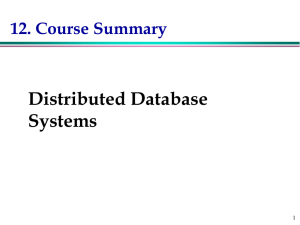
SACM
Internet-Draft
Intended status: Informational
Expires: December 10, 2014
N. Cam-Winget
Cisco Systems
June 8, 2014
Secure Automation and Continuous Monitoring (SACM) Requirements
draft-camwinget-sacm-requirements-04
Abstract
This document defines the scope and set of requirements for the
Secure Automation and Continuous Monitoring working group. The
requirements and scope are based on the agreed upon use cases.
Status of This Memo
This Internet-Draft is submitted in full conformance with the
provisions of BCP 78 and BCP 79.
Internet-Drafts are working documents of the Internet Engineering
Task Force (IETF). Note that other groups may also distribute
working documents as Internet-Drafts. The list of current InternetDrafts is at http://datatracker.ietf.org/drafts/current/.
Internet-Drafts are draft documents valid for a maximum of six months
and may be updated, replaced, or obsoleted by other documents at any
time. It is inappropriate to use Internet-Drafts as reference
material or to cite them other than as "work in progress."
This Internet-Draft will expire on December 10, 2014.
Copyright Notice
Copyright (c) 2014 IETF Trust and the persons identified as the
document authors. All rights reserved.
This document is subject to BCP 78 and the IETF Trust's Legal
Provisions Relating to IETF Documents
(http://trustee.ietf.org/license-info) in effect on the date of
publication of this document. Please review these documents
carefully, as they describe your rights and restrictions with respect
to this document. Code Components extracted from this document must
include Simplified BSD License text as described in Section 4.e of
the Trust Legal Provisions and are provided without warranty as
described in the Simplified BSD License.
Cam-Winget
Expires December 10, 2014
[Page 1]
Internet-Draft
Abbreviated Title
June 2014
Table of Contents
1. Introduction . . . . . . . .
2. Requirements . . . . . . . .
2.1. General SACM requirements
2.2. Requirements based on Use
3. Acknowledgements . . . . . .
4. IANA Considerations . . . . .
5. Security Considerations . . .
6. References . . . . . . . . .
6.1. Normative References . .
6.2. Informative References .
Author's Address . . . . . . . .
1.
. . .
. . .
. . .
Cases
. . .
. . .
. . .
. . .
. . .
. . .
. . .
.
.
.
.
.
.
.
.
.
.
.
.
.
.
.
.
.
.
.
.
.
.
.
.
.
.
.
.
.
.
.
.
.
.
.
.
.
.
.
.
.
.
.
.
.
.
.
.
.
.
.
.
.
.
.
.
.
.
.
.
.
.
.
.
.
.
.
.
.
.
.
.
.
.
.
.
.
.
.
.
.
.
.
.
.
.
.
.
.
.
.
.
.
.
.
.
.
.
.
.
.
.
.
.
.
.
.
.
.
.
.
.
.
.
.
.
.
.
.
.
.
.
.
.
.
.
.
.
.
.
.
.
.
.
.
.
.
.
.
.
.
.
.
2
2
2
4
5
5
5
5
5
6
6
Introduction
Today's challenges of evolving threats and improved analytics to
address such threats highlight a need to automate the securing of
both information and the systems that store, process and transmit the
information. SACM's charter focuses on addressing some of these
challenges in a narrower scope by bounding the task to address use
cases that pertain to the posture assessment of endpoints.
This document focuses on describing the requirements for facilitating
the exchange of posture assessment information, in particular, for
the use cases as exemplified in [I-D.ietf-sacm-use-cases].Also, this
document uses terminology defined in [I-D.ietf-sacm-terminology].
2.
Requirements
This document defines requirements based on the SACM use cases
defined in [I-D.ietf-sacm-use-cases]. This section describes the
requirements used by SACM to assess and compare candidate information
models and protocols to suit the architecture. These requirements
express characteristics or features that a candidate protocol or data
model must be capable of offering so as to ensure security and
interoperability.
2.1.
General SACM requirements
The use cases defined in [I-D.ietf-sacm-use-cases] apply to many
deployment scenarios. To ensure interoperability, scalability and
flexibility in any of these deployments, the following requirements
are defined for all use cases:
G-001 Extensibility: the data models, protocols and transports
defined by SACM must be extensible to allow support for non-standard
and future extensions. The transport protocol must support easily
Cam-Winget
Expires December 10, 2014
[Page 2]
Internet-Draft
Abbreviated Title
June 2014
adding new operations while maintaining backwards compatibility.
The query language must allow general inquiries as well as
expression of specific paths to follow; retrieval of specific
information based on an event, as well as on a continuous basis; and
the ability to retrieve specific pieces of information, specific
classes of information, and/or the entirety of available
information. The information model must accommodate the addition of
new data types and/or schemas in a backwards compatible fashion.
G-002 Interoperability: The data models, protocols and transports
must be specified with enough details and state machine to ensure
interoperability.
G-003 Scalability: The data models, protocols and transports must be
scalable. SACM must support a broad set of deployment scenarios.
As such, it is possible that the size or posture assessment
information can vary from a single assessment that is small in
(record or datagram) size to a very large datagram or a very large
set of assessments and must be addressed by the SACM specifications
defined.
G-004 Agility: The agility requirement is to ensure that the data
model, protocols, transports and its implementations are suitable to
fit in different deployment models and scenarios. Considerations
for the lightweight implementations of data models and transports is
required. Use cases, especially in the vulnerability assessment and
threat defense applications require time criticality in both
obtaining the information as well as consuming (e.g. parsing) the
data.
G-005 Transport variability: Different transports must be supported
to address different deployment and time constraints. Supporting
transports at the Layer 2, Layer 3 and higher application layers.
G-006 Extensibility: a method for expressing both standard and nonstandard (implementer-specific) data attributes while avoiding
collisions should be defined. For interoperability and scope
boundary, an explicit set of data attributes as mandatory to
implement should be defined and focused on Posture Assessment should
be described to allow for interoprability too.
G-007 Data Integrity: A method for ensuring data integrity must be
provided. This method is required to be available (i.e. all data-handling
components must support it), but is not required to be used in all cases.
G-008 Data Protection: Transport protocols must ensure data protection
for data in transit by encryption and robustness against protocol-based
attacks (such as reputation or store-and-forward attacks). Protection for
data at rest is not in scope for SACM. Data protection may be used for
both privacy and non-privacy scenarios.
G-009 Topology Flexibility: Both centralized and decentralized (peer-topeer) information exchange must be supported. Centralized data exchange
enables use of a common data format to bridge together data exchange
between diverse systems, and can leverage a virtual data store that
centralizes and offloads all data access, storage, and maintenance to a
dedicated resource. Decentralized data exchange enables simplicity of
sharing data between relatively uniform systems, and between small
numbers of systems, especially within a single enterprise domain; systems
can utilize an already established mutually agreed upon native data
format, which may be standard or implementation-specific.
G-010 Data Isolation: A method for partitioning of data must be
supported, to accommodate considerations such as geographic / regulatory
/ overlay boundaries and federation, where an organization may want to
differentiate between information that can be shared outside its own
domain and information that cannot. As with the requirement for data
integrity, this method is required to be available (i.e. all datahandling components must support it), but is not required to be used in
all cases.
G-011 Modularity: Announcement and negotiation of functional
capabilities (such as authentication protocols, authorization schemes,
data models, transport protocols, etc.) must be supported, enabling a
SACM component to make inquiries about the capabilities of other
components in the SACM ecosystem.
G-012 Versioning / Backward Compatibility: Announcement and negotiation
of versions of existing capabilities (such as transport protocols, data
models, specific attributes within data models, standard attribute
expression sets, etc.) must be supported, to accommodate future growth
and mixed-capability ecosystems.
G-013 Discovery: The solution must provide a mechanism for components to
discover what information is available across the ecosystem (i.e. a
method for cataloging data available in the ecosystem and advertising it
to consumers), and where to go to get a specific piece of that
information (i.e. a method by which a node can locate the advertised
information), so consumers don’t have to have a priori knowledge to find
available information.
G-014 Synchronization: Request and response operations must be
timestamped, and published information must capture time of publication.
Actions or decisions based on time-sensitive data (such as user
logon/logoff, endpoint connection/disconnection, endpoint behavior
events, etc.) are all predicated on a synchronized understanding of time.
A method for detecting and reporting time discrepancies must be provided.
Cam-Winget
Expires December 10, 2014
[Page 3]
Internet-Draft
2.2.
Abbreviated Title
June 2014
Requirements based on Use Cases
This section describes the requirements that may apply to information
models, data models, protocols or transports as identified by the use
cases in [I-D.ietf-sacm-use-cases] and referenced by the section
numbers from that draft.
REQ-001 Attribute Dictionary: Use Cases in the whole of Section 2
describe the need for an Attribute Dictionary. With SACM's scope
focused on Posture Assessment, the attribute collection and
aggregation must have a well understood set of attributes inclusive
of their meaning or usage intent.
REQ-002 Information Model: Use Case 2.1.1 describes the need for an
Information Model to drive content definition. As SACM endeavors to
reuse already existing standards which may have their own data
models defined by instantiating an information model, the data
models can be mapped to SACM's information model. See [RFC3444] for
a description and distinctions between an information and data
model.
REQ-003 Data Model to Protocol mapping: Use Case 2.1.1 describes the
need to instantiate a data model that can map to the SACM protocols
for posture content operations such as publication, query, change
detection and asynchronous notifications.
REQ-004 Endpoint Discovery: Use Case 2.1.2 describes the need to
discover endpoints and their composition.
REQ-005 Attribute based query: Use Case 2.1.2 describes the need for
the data model to support a query operation based on a set of
attributes to facilitate collection of information such as posture
assessment, inventory (of endpoints or endpoint components) and
configuration checklist. .
REQ-006 Information based query with filtering: Use Case 2.1.3
describes the need for the data model to support the means for the
information to be collected through a query mechanism. Furthermore,
the query operation requires filtering capabilities to allow for
only a subset of information to be retrieved. The query operation
may be a synchronous request or asynchronous request.
REQ-007 Asynchronous publication, updates or change modifications
with filtering: Use Cases 2.1.3, 2.1.4 and 2.1.5 describe the need
for the data model to support the means for the information to be
published asynchronously. Similarly, the data model must support
the means for a requestor to obtain updates or change modifications
asynchronously. Like the query operation, these update
Cam-Winget
Expires December 10, 2014
[Page 4]
Internet-Draft
Abbreviated Title
June 2014
notifications can be set up with a filter to allow for only a subset
of posture assessment information to be obtained.
REQ-008 Data model scalability: Use Cases 2.1.4 and 2.1.5 describes
the need for the data model to support scalability. For example,
the query operation may result in a very large set of attributes as
well as a large set of targets.
REQ-009 Separation of Collection Request and Collection Action: the
data model must distinguish the means to request for a data item to
include enough information to properly identify the item to collect
but the request could be separate and distinct from the actual
method or process used to fulfill the request.
2.3 Requirements for the Information Model
Specific requirements for the information model/data model
* Uniqueness of objects of reference, such as endpoints, IP
addresses, etc.
* Mechanism to resolve or tolerate ambiguity in referents
(e.g. same IP address used in two separate networks)
* Support for rootless searches / wildcard searches
* Ability to start a search anywhere in the tree, rather
than at a specific leaf
* Data lifetime management (longevity / expiration of data)
* Data ephemerality (update vs. notify)
* Looseness of coupling between producer and consumer
* Ability to identify data from a specific producer
* Metadata cardinality - single-valued vs. multi-valued
* Capability negotiation - what data types / schemas are
supported
* Provenance of data - for example:
* Publisher identity, classification, trustworthiness,
authoritativeness
* Freshness of data
* Method by which data was generated (i.e. self-reported,
reported by aggregator, result of scan, etc.)
* Location of data
* Delta results vs. total results
IM-0?? Freshness: Published data must be associated with the time of
origination - separately from the time of publication required in G-014 so consumers can make decisions about the relevance of the data based on
its currency and/or age.
2.4 Misc Requirements (from Gunnar, not sure where these go yet)
Collection separation
o The request for a data item must include enough information to
properly identify the item to collect, but the request shall not be
a command to directly execute nor directly applied as arguments to
a command. The purpose of this requirement is primarily to reduce
the potential attack vectors, but has the additional benefit of
abstracting the request for collection from the collection method
thereby allowing more flexibility in how collection is implemented.
Collection composition
o A collection request can be composed of other collection requests
(which yield collected values). This must be able to be expressed
as part of the collection request so that these references can be
resolved at the point of collection without having to interact with
the requester.
3.
Acknowledgements
The authors would like to thank Barbara Fraser, Jim Bieda and Adam
Montville for reviewing and contributing to this draft.
4.
IANA Considerations
This memo includes no request to IANA.
5.
Security Considerations
This document defines the requirements for SACM. As such, it is
expected that several data models, protocols and transports may be
defined or reused from already existing standards. This section will
highlight security considerations that may apply to SACM based on the
architecture and standards applied in SACM.
To address security and privacy considerations, the data model,
protocols and transport must consider authorization based on consumer
function and privileges, to only allow authorized consumers and providers
to access specific information being requested or published.
To enable federation across multiple entities (such as across
organizational or geographic boundaries) authorization must also extend
to infrastructure elements themselves, such as central controllers /
brokers / data repositories.
In addition, authorization needs to extend to specific information or
resources available in the environment. In other words, authorization
should be based on both subject (the information requestor) and object
(the information requested). The method by which this authorization is
applied is unspecified.
6. References
6.1.
Normative References
[I-D.ietf-sacm-terminology]
Waltermire, D., Montville, A., Harrington, D., and N. CamWinget, "Terminology for Security Assessment", draft-ietfsacm-terminology-04 (work in progress), May 2014.
[I-D.ietf-sacm-use-cases]
Waltermire, D. and D. Harrington, "Endpoint Security
Posture Assessment - Enterprise Use Cases", draft-ietfsacm-use-cases-07 (work in progress), April 2014.
[RFC2119]
Cam-Winget
Bradner, S., "Key words for use in RFCs to Indicate
Requirement Levels", BCP 14, RFC 2119, March 1997.
Expires December 10, 2014
[Page 5]
Internet-Draft
6.2.
Abbreviated Title
June 2014
Informative References
[RFC3444]
Pras, A. and J. Schoenwaelder, "On the Difference between
Information Models and Data Models", RFC 3444, January
2003.
[RFC5209]
Sangster, P., Khosravi, H., Mani, M., Narayan, K., and J.
Tardo, "Network Endpoint Assessment (NEA): Overview and
Requirements", RFC 5209, June 2008.
Author's Address
Nancy Cam-Winget
Cisco Systems
3550 Cisco Way
San Jose, CA 95134
US
Email: ncamwing@cisco.com
Cam-Winget
Expires December 10, 2014
[Page 6]









